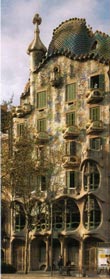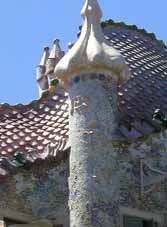The house Batlló (1904-1906)

 It is the Gaudí's second house in the Eixample and his first one in Gràcia's walk. Actually, it is the reform of a preexisting building, which there entrusted him on November 7, 1904 by their owners, Josep Batlló i Casanovas and his wife Amàlia Godó. Gaudí expanded the interior court, changed the fronts of the street and of the interior, crowned the building with a new cover and re-did the floors, singularly the principal one inhabited by the family Batlló. There helped him the architects Domènec Sugranyes and Josep Canaleta, in the construction; and the architects Joan Rubió and Josep Maria Jujol and the sculptors Josep Llimona, Carles Mani and Joan Matamala, in the decoration. The works were ended in 1906.
Gaudí directed personally from the sidewalk of Gràcia's walk the placement of the pieces of the front, of undulating surface. It is a great pictorial composition, brilliant with the Mediterranean light, that it distributes on a flowery field the bones of the banquet of the Dragoon, in whose loin is fixed the lance of saint George. The hilt of this lance is a bulbous cross of four arms orientated according to the cardinal points. It has spirally the monograms in gold of the persons of the Sacred Family: Jesus (JHS), Maria (M) and Joseph (JHP). The balconies represent skulls and the platform, phalanxes of the fingers. The models of plaster of all these elements were done in the workshops of the Sacred Family.
The house has two floors of garrets, done with vaults on arches of brick of parabolic profile, like ribs. Every parabolic arch starts of the end of a girder of iron of the soil, which it does of brace; an ingenious structural innovation that Gaudí will repeat extended in the garrets of the Quarry. The decoration of the principal flat has many Gaudí's extraordinary details, as the chimney; the roofs of plaster with relief; the chapel, with Llimona's altarpiece; the large windows on Gràcia's walk and other windows; the furniture of the dining room; the ceramics of the interior court; the rails of the stairs and the pavement.
The house Batlló (1904-1906) is the culmination of the Catalan Baroque of the house Calvet (1898-1899). Gaudí liberates his inventiveness of the stylistic inflexibility and creates much more organic and blurred forms, with a spectacular color. This architectural freedom, this baroque very personal of Gaudí, will come to its exuberance in the Quarry (1906-1912), entrusted to Antoni Gaudí for Pere Milà precisely during a visit to the works of the house of his friend Josep Batlló. It is advisable to visit the three houses for this order.
The magazine of Madrid (Spain) "Nuevo Mundo" of February 14, 1907 was saying on the modernist Catalan architects: «Neither coming still to the perfection or at least to the just conciliation of the beautiful thing, the harmonic thing and the useful thing, not even constituting still their works the clear and precise vision of one own art, it is an advertisement of abundant aptitudes for coming to this glorious goal from whom can be considered to be like nearer to the picturesque and bold Gaudí.»
"Ilustració Catalana" was answering on March 10, 1907: «The same Spanish start yielding to the reality and deal and comment, still airily, on the works of Domènech, Puig i Cadafalch, Sagnier, Gaudí and different so many people. (…) The house Batlló (…), that so extraordinarily has called the attention of the public, is full of originality. There have not stopped being discussed the works of this distinguished architect, but this one has deserved the honors of the critique, of the initiated ones and of the laymen. (…) There seems that to the man who is lifting the temple of the Sacred Family, colossal work that admires everybody, would not have to come to him the critique of his works; but our people does not have brake in certain things, and even in the most intangible things they say, of what his author must not have been a nuisance the most minimal, since man of culture and of world, can give the value that is deserved to the more or less just judgments of the public opinion.»
It is the Gaudí's second house in the Eixample and his first one in Gràcia's walk. Actually, it is the reform of a preexisting building, which there entrusted him on November 7, 1904 by their owners, Josep Batlló i Casanovas and his wife Amàlia Godó. Gaudí expanded the interior court, changed the fronts of the street and of the interior, crowned the building with a new cover and re-did the floors, singularly the principal one inhabited by the family Batlló. There helped him the architects Domènec Sugranyes and Josep Canaleta, in the construction; and the architects Joan Rubió and Josep Maria Jujol and the sculptors Josep Llimona, Carles Mani and Joan Matamala, in the decoration. The works were ended in 1906.
Gaudí directed personally from the sidewalk of Gràcia's walk the placement of the pieces of the front, of undulating surface. It is a great pictorial composition, brilliant with the Mediterranean light, that it distributes on a flowery field the bones of the banquet of the Dragoon, in whose loin is fixed the lance of saint George. The hilt of this lance is a bulbous cross of four arms orientated according to the cardinal points. It has spirally the monograms in gold of the persons of the Sacred Family: Jesus (JHS), Maria (M) and Joseph (JHP). The balconies represent skulls and the platform, phalanxes of the fingers. The models of plaster of all these elements were done in the workshops of the Sacred Family.
The house has two floors of garrets, done with vaults on arches of brick of parabolic profile, like ribs. Every parabolic arch starts of the end of a girder of iron of the soil, which it does of brace; an ingenious structural innovation that Gaudí will repeat extended in the garrets of the Quarry. The decoration of the principal flat has many Gaudí's extraordinary details, as the chimney; the roofs of plaster with relief; the chapel, with Llimona's altarpiece; the large windows on Gràcia's walk and other windows; the furniture of the dining room; the ceramics of the interior court; the rails of the stairs and the pavement.
The house Batlló (1904-1906) is the culmination of the Catalan Baroque of the house Calvet (1898-1899). Gaudí liberates his inventiveness of the stylistic inflexibility and creates much more organic and blurred forms, with a spectacular color. This architectural freedom, this baroque very personal of Gaudí, will come to its exuberance in the Quarry (1906-1912), entrusted to Antoni Gaudí for Pere Milà precisely during a visit to the works of the house of his friend Josep Batlló. It is advisable to visit the three houses for this order.
The magazine of Madrid (Spain) "Nuevo Mundo" of February 14, 1907 was saying on the modernist Catalan architects: «Neither coming still to the perfection or at least to the just conciliation of the beautiful thing, the harmonic thing and the useful thing, not even constituting still their works the clear and precise vision of one own art, it is an advertisement of abundant aptitudes for coming to this glorious goal from whom can be considered to be like nearer to the picturesque and bold Gaudí.»
"Ilustració Catalana" was answering on March 10, 1907: «The same Spanish start yielding to the reality and deal and comment, still airily, on the works of Domènech, Puig i Cadafalch, Sagnier, Gaudí and different so many people. (…) The house Batlló (…), that so extraordinarily has called the attention of the public, is full of originality. There have not stopped being discussed the works of this distinguished architect, but this one has deserved the honors of the critique, of the initiated ones and of the laymen. (…) There seems that to the man who is lifting the temple of the Sacred Family, colossal work that admires everybody, would not have to come to him the critique of his works; but our people does not have brake in certain things, and even in the most intangible things they say, of what his author must not have been a nuisance the most minimal, since man of culture and of world, can give the value that is deserved to the more or less just judgments of the public opinion.»
All rights reserved
Last update: 06/05/2016